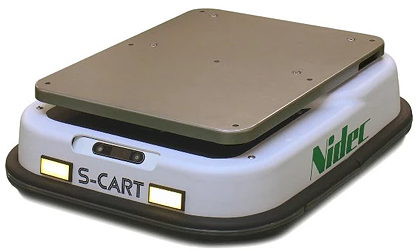The new AGV is a variant on Nidec-Shimpo’s S-Cart range of AGVs, which it launched in 2016. These have previously used 2D laser sensors to detect their position, allowing them to operate without needing magnetic tapes to be laid out on the floor. Although this allows changes to be made to the layout of factories or warehouses, if there are large-scale changes, users sometimes have to place “landmark” objects to help the AGVs to navigate their changed surroundings.
The new vehicle overcomes these limitations by using a stereo camera for real-time detection of its surroundings in three dimensions. It relies on a technology called Visual Slam (simultaneous localisation and mapping), developed by Canon, which simultaneously determines its surroundings in three dimensions and the location of the AGV, based on wide-angle (horizontal as well as vertical) video images captured by the camera.
Nidec-Shimpo has combined Canon’s image-processing technology with its own dynamic control technology for guideless AGVs. The two companies have been testing prototypes of the new AGV in their own factories since 2019.

Nidec-Shimpo says that its new AGV is the first to use vision-based navigation
The first S-Cart-V AGV is based on the 100kg payload version of the original S-Cart, which can move at speeds of up to 60m/min. Nidec-Shimpo says it is planning to launch other models with visual-based navigation.

